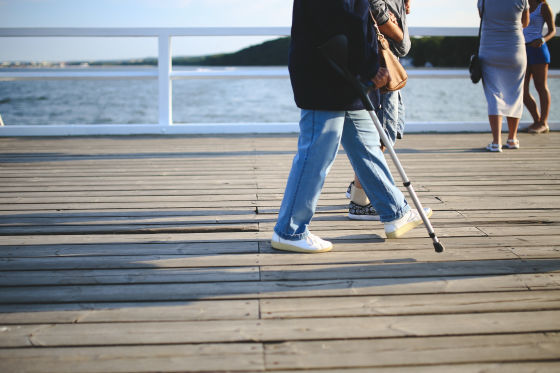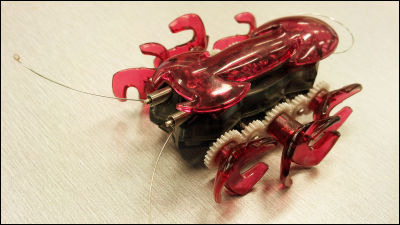Seven tips to practice eco-location to 'see' the surrounding situation by sound alone

by Oleksandr Pidvalnyi
Bats and dolphins can know the circumstances by taking the echo of "sound" that they brought out. However, it is possible to "see" the surroundings using the sounds of yourself, in situations where human eyes can not see. Daniel Kish , proficient in ecolocation (echolocation), has released tips on its practice.
Teach Yourself to Echolocate - Atlas Obscura
https://www.atlasobscura.com/articles/how-to-echolocate
Daniel Kish, who was born with binocular retinoblastoma (retinal cancer), lost sight of both eyes in 13 months after birth. Mr. Kish who was taught to use the ecolocation in moving, as of 2018, walking while tingling "tits" and tongue, you can grasp the surrounding situation from the reverberation sound. By sounding a tongue, Mr. Kish seems to be able to draw the walls and the position of the door in the head.
You can see in the following movie how Mr. Kish is grasping the surrounding by moving while tongue is ringing.
Go around the world by "seeing" by sound - YouTube
Kissh believes that eco-location supports confidence and self-reliance of an invisible person, and launched a non-profit organization called " World Access for the Blind ", teaching ecolocation mainly to blind people It is.
Actually Kischi riding a bicycle ......
Blind as a Bat: Seeing Without Eyesight - YouTube
It is possible to cross the roadway.
Human echolocation lets blind man 'see' - YouTube
To be able to eco-location human beings is supported by numerous research. Researchers at the University of California at Berkeley show that experiments can be applied to which one of the two objects in front of you is big, by ringing the tongue even if you are a novice in the ecolocation.
People who can not see their eyes and who use ecolocation can distinguish the difference between echinochloa and evergreen tree from the reverberation, such as to pull off a difficult technique for those with visible eyes, I will make the other feeling awful. " Important items when Quiche says "Listen" to the surrounding sight are as follows.
◆ 1: Practice listening to sound

by Alexas_Fotos
Before starting the eco-location, you should first practice to feel the change in the environmental sound around you. When you get on a seat other than the driver 's seat of the car, close your eyes, open your window and listen to the sounds of the various places you pass through. "In a residential area, when the car is running next to the road parking, trees, posts, mailboxes and houses, it should be heard by sound." "When the car passes through, the sounds generated from the car are reflected back to the surroundings It sounds like, "Kissh.
◆ 2: Get the necessary tools
Blocking one sense, another sensation is sharpened. So, if you have good eyes, please use eye mask etc for blindfold. And for practice you also need a metal bowl or tray. When practicing eco-location while moving, you need to use a cane or borrow a hand of a trustworthy person.
◆ 3: Choosing a location <br> Mature Eco Locators like Qish says to care about the materials in the room. Indoor decorations with tin and anchor walls are said to "make the sound alive." These materials "sing to you", Kish said, it seems easier to do eco-location. When beginners practice ecolocation, avoid places where there is no sound echoing, places where there is a possibility that sound like the beach can be disturbed. "It is quiet, it is not cluttered, and open space that is not a reverberation room " is said to be the best.
◆ 4: Practice tongue ringing

by Oleg Magni
There are good sounds and bad sounds in the tongue ringing. A tongue sound like two sounds overlapping may overlap the reverberation sound. It is important to produce reliable sound.
Beginners use teeth to make sounds, Kish says that sound like a tongue is recommended. Or "sound" corresponding to "ch" of "check" "church". What is important is to find out how to sound the sound that suits yourself, and once you decide "this way" you should continue with that way.
◆ 5: Beginning simple <br> There are three goals of tongue sounding, first recognition of "exist / none", then recognition of "what direction is in?", The third is "how far Is there a place in the place? " When doing this exercise, Mr. Kish makes two students a pair, and one person raises a bowl and a tray over the other person 's head. Ringing the tongue causes the bowl and tray to echo the sound, so we guess the position from there.
Mr. Kish performs a tongue only when changing the "map" in his head, but in practice you can understand how to pick up the reverberation by frequently changing the position of the tray or bowl.
◆ 6: Try while moving

by Kaboompics
After understanding the method of tongue ringing and how to pick up the sound, the next method to do "to do while moving". If you tongue while walking in the corridor, you may find the presence of doors and turns.
It will be fumbling at first, so it is OK even if you ask the partner for "the right way", but keep blindfolded. The feeling that "I want to remove blindfolds" may become large, but since people at this time are in the process of adaptation process, it seems that everything will be ruined by removing blindfolds.
◆ 7: Putting a break at the required timing <br> It is exciting and feeling confusing to feel the world in a completely new way. Mr. Kish said he has seen eyes and he / she has been trained by people who are not accustomed to "not depending on vision" and needs to take a break every 35 to 40 minutes. People who can not see their eyes get used to it, so they can train for a longer time.
Eco-location requires training and perseverance. It may take time to become good at eco-location, but by doing eco-location we can "see" a whole new world.
Related Posts:
in Note, Posted by darkhorse_log






